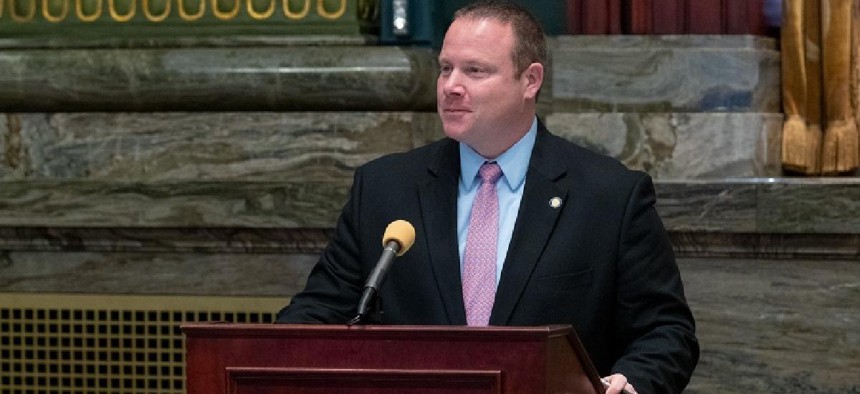Education
Senate GOP seeks to expand tax credits for educational scholarships

Senator Scott Martin Pennsylvania Senate Republican Caucus
As Gov. Tom Wolf continues to advocate for his own slate of reforms to Pennsylvania’s education system, Republican lawmakers appear to be taking a different approach, eyeing an expansion of educational tax credits designed to create more scholarships for students to attend private schools.
Citing a growing desire for educational alternatives, Senate Republicans unveiled legislation in committee that would expand two tax credit programs that provide tax breaks to businesses that donate to scholarship organizations and other educational initiatives.
Under the existing Educational Improvement Tax Credit (EITC) Program and the Opportunity Scholarship Tax Credit (OSTC) Program, businesses may receive tax credits worth up to $750,000 per year if they provide financial contributions to fund scholarships for public and private schools.
Senate Bill 1 would expand the state cap on tax credits for both scholarship programs, increasing tax credits available under the EITC program from $185 million to $300 million, and increasing the OSTC program from $55 million to $100 million.
The bill would also require more than 60% of EITC contributions – or $185 million – to go toward scholarships, and require at least $50 million to go toward educational improvement organizations each year.
SB 1 would also automatically increase the cap for both tax credits by 25% each year if at least 90% percent of available tax credits were approved in the prior year.
Proponents say the legislation would provide more students with access to educational alternatives – as the EITC program allows students to use the scholarships to attend private schools and the OSTC program allows students in low-achieving schools to use scholarships for public or private institutions.
“Senate Bill 1 promotes the role and freedom of parents and families to choose the right learning environment for their student, not for the government to decide,” said Senate Education Committee Chair Scott Martin, who is the prime sponsor of the bill. “By increasing caps on EITC and OSTC programs and expanding access and funding to the economically disadvantaged schools program, more students will have the opportunity to obtain the education they need and deserve, and not be locked out due to an oversubscription of the program.”
Republican sponsors of the bill pointed to data from the Department of Community and Economic Development that found that thousands of students who applied for scholarships under the EITC and OSTC programs had their applications denied.
“These numbers represent tens of thousands of students that, for one reason or another, are looking for a different path, a better path, and they are being turned away,” Martin said.
Senate President Pro Tempore Jake Corman, who is a sponsor of the bill, said the number of denials indicate that the program is popular and that it should be expanded.
“Certainly, one of the more important measurements of whether something is successful or not is how many people want it. There's a huge line for EITC and for options for kids and parents to be able to figure out ways to best educate their children,” he said.
But while SB 1 received strong support from its Republican sponsors, Democrats and teachers unions viewed the bill as an affront to public education. State Sen. Lindsey Williams, the Democratic chair of the Senate Education Committee, called the bill “a massive tax break for corporations, which ultimately leads to increased school property taxes for average Pennsylvanians.”
State Sen. Tim Kearney, also a Democrat, said the legislature should better fund public school districts rather than expand the tax credit programs.
“At a time when our school districts are struggling and our taxpayers are dealing with high property taxes, rather than address this issue, the legislature is preparing to defund public education, which will only amplify the greater financial struggles for school districts and our taxpayers,” Kearney said in committee, adding that SB 1 “takes hundreds of millions of dollars out of schools without making any reforms to reduce their costs.”
SB 1 also alarmed public school advocates and teachers unions across the state. In a memo sent to members of the General Assembly last week, Philadelphia Federation of Teachers President Jerry Jordan outlined a range of concerns with the legislation, from the establishment of a Public Charter School Commission tasked with reviewing charter applications to the expansion of the tax credit programs.
“This would be catastrophic for public education and the students we serve, and a boon for corporations looking to profit in the name of faux charity,” Jordan wrote in the memo.
Pennsylvania State Education Association Rich Askey framed the bill in stark terms, saying the bill “could be the largest transfer of taxpayer dollars out of public schools in Pennsylvania’s history – and just about the worst attack on public education we’ve ever seen.”
But while the bill has Democrats and public education advocates in a state of worry, Republicans have an uphill climb ahead of them if they want to get it signed into law. When asked about the governor’s stance on the bill, Wolf spokesperson Lyndsay Kensinger called it a “non-starter.”
“The administration does not support the bill in its current form,” Kensinger wrote in an email. “Various components of this bill make this bill a non-starter. One example is the creation of another unelected, unaccountable form of Harrisburg bureaucracy appointed by political insiders will only result in increased costs to local school districts that will be paid for by increasing property taxes for Pennsylvanians.”
In recent weeks, Wolf has toured the state to tout his own plan for education in Pennsylvania, which places a particular focus on charter schools.
Kensinger added that the administration is open to negotiating with lawmakers on “a serious reform bill that would improve educational quality, increase transparency, and contain taxpayer costs.”
